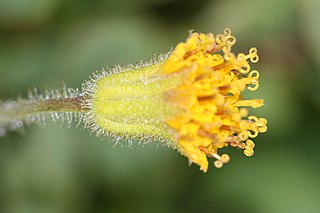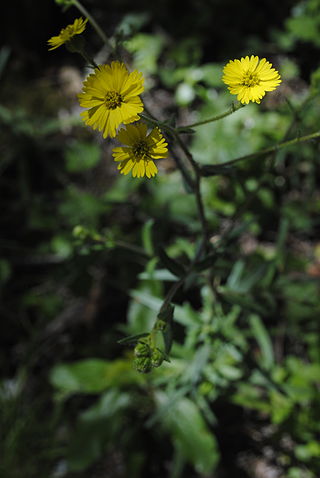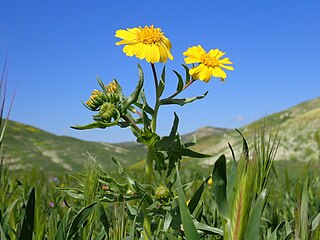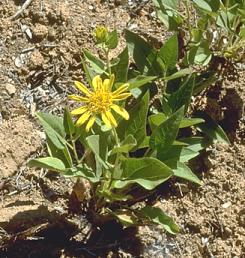
Helianthus bolanderi is a species of sunflower known by the common names Bolander's sunflower and serpentine sunflower. It is native to California and Oregon, where it grows mainly in mountainous areas, often in serpentine soils. It has been found from southwestern Oregon as well as in northern and central California as far south as Santa Cruz County, with reports of a few isolated populations in southern California.

Arnica parryi is a North American species of flowering plant known by the common names Parry's arnica or nodding arnica. It is native to western Canada and the western United States as far south as Inyo County, California and McKinley County, New Mexico. It grows in temperate coniferous forests and alpine meadows in mountainous areas, primarily the Rocky Mountains, Cascades, and Sierra Nevada.
Crepis bakeri is a species of flowering plant in the family Asteraceae known by the common name Baker's hawksbeard. It is native to the western United States where it grows in many types of mountain and plateau habitat. It is found in Oregon, Washington, Idaho, northern California, Nevada, and Utah.

Crepis modocensis is a species of flowering plant in the family Asteraceae known by the common name Modoc hawksbeard.
Madia anomala is a species of flowering plant in the family Asteraceae known by the common name plumpseeded madia. It is endemic to northern California, where it can be found on hillsides in the San Francisco Bay Area and adjacent mountains and valleys.
Harmonia doris-nilesiae is a species of flowering plant in the family Asteraceae known by the common names serpentine tarweed and Niles' madia.

Madia exigua is a species of flowering plant in the family Asteraceae known by the common names small tarweed and threadstem madia.

Madia glomerata is a species of flowering plant in the family Asteraceae known by the common name mountain tarweed.
Harmonia hallii is a species of flowering plant in the family Asteraceae known by the common names Hall's harmonia and Hall's madia.

Anisocarpus madioides is a North American species of flowering plant in the family Asteraceae known by the common name woodland madia.
Harmonia nutans is a species of flowering plant in the family Asteraceae known by the common name nodding madia.

Madia radiata is a species of flowering plant in the family Asteraceae known by the common names golden madia and showy madia. It is endemic to California, where it is known mostly from the Central Coast Ranges and adjacent edges of the San Francisco Bay Area and Central Valley.

Jensia rammii is a species of flowering plant in the family Asteraceae known by the common name Ramm's madia. It is endemic to California, where it is limited to the northern slopes of the Sierra Nevada and its foothills.

Madia sativa, known by the common names coast tarweed and Chilean tarweed, is a species of flowering plant in the family Asteraceae found in parts of western North and South America.
Jensia yosemitana is a species of flowering plant in the family Asteraceae known by the common name Yosemite tarweed. It is endemic to California, where it has a scattered distribution across the Sierra Nevada and its foothills. Some of the populations lie inside Yosemite National Park.
Phalacroseris is a monotypic genus of flowering plants in the family Asteraceae containing the single species Phalacroseris bolanderi, which is known by the common name Bolander's mock dandelion.
Carlquistia is a rare North American genus of flowering plants in the family Asteraceae containing the single species Carlquistia muirii. Formerly named Raillardiopsis muirii, the plant was reexamined in the 1990s and moved to a new genus of its own, separate from similar and closely related genera, such as Madia. Common names for the species include Muir's tarplant, Muir's raillardiopsis, and Muir's raillardella.

Packera bolanderi is a species of flowering plant in the aster family known by the common names Bolander's ragwort and seacoast ragwort. It is native to the west coast of the United States from Washington to northern California, where it grows in wet coastal forests and woodlands. There are two varieties of the species which differ slightly in morphology and habitat occupied; these varieties have been considered separate species by some authors. The var. bolanderi has thicker leaves, occurs farther south, and occupies more open types of habitat, than does var. harfordii. This plant in general is a perennial herb producing one to three stems up to half a meter tall. The basal leaves have blades up to 12 centimeters long which are divided into several lobes and borne on long, thin petioles. Leaves growing farther up the stem are smaller and have more lobes on their blades. The inflorescence contains several flower heads, each lined with dark green phyllaries. The head contains many golden yellow disc florets and generally either 8 or 13 yellow ray florets each over a centimeter long. The fruit is an achene tipped with a pappus of bristles.

Agnorhiza bolanderi is a species of flowering plant known by the common name Bolander's mule's ears. It is endemic to California, where it is known only from a narrow section of the Sierra Nevada foothills about 275 kilometers long from Shasta County to Mariposa County. It grows in chaparral and grassland habitat, usually on serpentine soils.

Agnorhiza reticulata, known by the common name El Dorado County mule's ears, is a rare species of flowering plant found only in a small region of north-central California.












